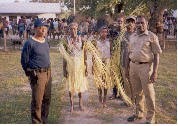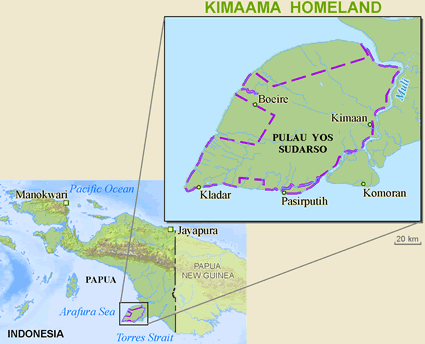The Kimaama are also known as Kimaghama, Kimaghima, Kaladdarsch or Teri-Kalwasch. The story goes that the Kimaama people originally came from the main Papua island.
The Kimaghimas primarily live by hunting, gardening, and fishing in the swamplands of their island homeland. With their land at an altitude of less than 100 meters above sea level the Kimaghima people can best be accessed by boat. There is an airstrip in Kimaam and a road to Padua from Kimaam. Otherwise, canoeing and walking is the best way to get around.
They enjoy the "Ndambu" dance and "wati" (an intoxicating drink) is used for many activities. When marrying after age 18 a man must pay the bride's family the bride price or give his own sister to be married to someone in the other family. Upon death the Kimaghima people are buried quickly (death is thought to be contagious). They're often buried in their own canoe.
Two junior high schools are in the area.
The clothing people wear is usually modern. The people eat yams, sugarcane, bananas, yams, coconuts, and sago. The Kimaghima peoples use machetes for many things and bow and arrows for hunting. Houses are generally "gubuk"-style built on stilts with rooves of pleated sago or other leaves. The infrastructure in the area includes SSB radios and PLN evening electricity in Kimaam. The people identify themselves by the town from which they come. Around the district capital of Kimaama the people get their drinking water from wells.
About two-thirds identify as Christian. The Catholic Church is strong in the area but traditional influences are widely evident.
With tropical swamps everywhere, malaria is common. Skin diseases and lack of a nutritious diet also frequently cause health problems. Several health clinics are in the area.
Pray for Kimaghima elders and family leaders to open the door to evangelism and discipleship.
Pray for Kimaghima disciples who are zealous to spread the fragrance of Christ to their community and to others.
Pray that traditional barriers to the gospel would be broken down.
Pray for the Holy Spirit to bless Kimaghima families with the realization that they need a sin-free Savior who offers abundant life.
Scripture Prayers for the Kimaghima in Indonesia.
GMI Papua
| Profile Source: Joshua Project |











